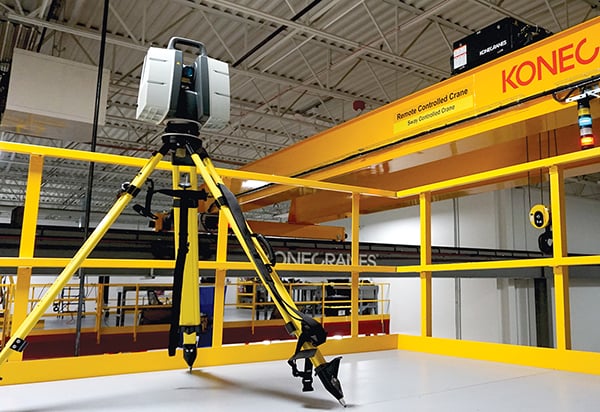Lasers at cutting edge of crane safety, savings
Jeff Rice, Service Products/Crane Reliability
Although they’ve been around for almost two decades, lasers continue to significantly impact the crane industry. Thanks to laser-driven improvements in crane technology, many facilities are maintaining equipment more proactively, efficiently, and safely than ever.
Lasers and collision avoidance
For starters, lasers have enhanced collision avoidance systems by increasing opportunities for customization. Unlike ultrasonic collision avoidance, laser-based collision avoidance features can account for multi-dimensional crane travel patterns, customized zones, and adjustable boundaries. These improved safety capabilities are particularly important in facilities that house multiple bays in relatively small spaces. Of course, even carefully programmed laser-based collision avoidance cannot replace well-trained, vigilant operators.
Lasers and Crane Reliability Studies
More importantly, lasers have transformed Crane Reliability Studies (CRS), or rail and crane surveys designed to diagnose critical structural and mechanical issues. Before lasers, CRS for both crane rails and crane geometry—the process of determining whether a crane runs squarely —was performed with tape or piano wire and several human measurers.
Because it’s nearly impossible to maintain perfect angles and tautness, this method was prone to error and therefore frequently produced inaccurate results. Additionally, CRS for crane rails used to take many hours (sometimes disabling the crane for multiple shifts) and pose safety concerns, as it required at least three technicians to measure on top of the rails for extended periods of time.
Now powered by lasers, CRS is remarkably more effective and efficient today. Modern CRS for crane rails provides highly accurate insights into rail straightness, elevation, and span. Konecranes RailQ Runway Survey, for example, uses proprietary visualization technology and a remote-controlled robot trolley which runs along the rail to collect data to identify tracking issues and misalignments. Using this data, Konecranes analysts recommend repairs and routine maintenance plans.
The whole process is relatively quick and safe because a robot, not humans, measures the rails. RailQ prevents critical problems that can lead to accelerated wear, dangerous malfunctions such as falling flanges, and the expense of unplanned repairs.
In addition to improving CRS processes and accuracy, lasers have rendered CRS an invaluable tool for proactive crane maintenance. Since RailQ was introduced in 2008, we’ve observed a huge uptick in rail surveys and crane geometry utilization—and many success stories about proactive maintenance as a result. Some of our customers have even begun to implement annual CRS crane rail and crane geometry surveys to inform proactive, money-saving maintenance plans.
What’s next in laser technology?
 Konecranes has introduced the RailQ 3D Runway Survey. RailQ 3D uses the latest high-definition surveying technology combined with point cloud data analysis to provide information on runway condition. The 3D laser scanner can take up to 1 million measurements a second to generate a realistic model of a crane bay. Multiple 3D scans can be added together through a process called registration to build a larger and more detailed model of the environment.
Konecranes has introduced the RailQ 3D Runway Survey. RailQ 3D uses the latest high-definition surveying technology combined with point cloud data analysis to provide information on runway condition. The 3D laser scanner can take up to 1 million measurements a second to generate a realistic model of a crane bay. Multiple 3D scans can be added together through a process called registration to build a larger and more detailed model of the environment.
In the not-so-distant future, we expect two major developments in laser technology to improve the way crane issues are diagnosed and repaired. The first is laser-based, dynamic measuring capabilities. While current CRS methods examine cranes and runways at rest, dynamic measuring will allow technicians to assess them as they handle loads. This kind of data will provide a more robust picture of how cranes function and therefore will improve the insights and recommendations that service professionals are able to provide. Secondly, lasers will eventually be used to place equipment accurately during the repair process, ensuring that every repair is executed perfectly the first time.
Learn more about our consultation services like CRS and RailQ

 Konecranes has introduced the
Konecranes has introduced the